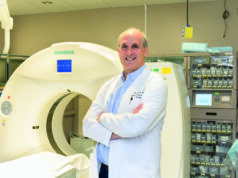
An 11-year prospective study of magnetic resonance (MR)-guided cryoablation in the treatment of recurrent cancer in the prostate bed has demonstrated “significant” prostate-specific antigen (PSA) reduction at both six- and 12-month follow-up.
These findings were presented by Setayesh Sotoudehnia Korani (Mayo Clinic, Rochester, USA) at the Society of Interventional Oncology (SIO) annual scientific meeting (30 January–3 February, Las Vegas, USA).
Sotoudehnia began by outlining current treatment options and their associated recurrence rates, stating that surgery is estimated to have a recurrence rate of between 15–20%, radiation 20–30%, and hormone therapy, which has a two-to-three-year efficacy rate. Of available focal therapies, the speaker listed cryoablation and laser ablation.
In order to evaluate the efficacy and safety of MR-guided cryoablation in this patient population, Sotoudehnia and colleagues enrolled 90 patients between September 2011 and September 2023. The patients had a mean age of 73 years and had previously received radiation therapy or prostatectomy.
Patients in the study cohort were treated with four cryoablation needles on average, typically with three freeze/thaw cycles and a urethral warmer for protection during the procedure. Sotoudehnia stated that their team carefully monitored ice ball expansion via magnetic resonance imaging (MRI) to ensure target coverage.
At three and six months post-ablation, patients were assessed via PSA and prostate-specific membrane antigen (PSMA) positron emission tomography (PET) imaging. Urinary symptoms and sexual health were measured using the American Urological Association Symptom Score (AUASS) and the Expanded Prostate Cancer Index Composite (EPIC).
Sharing the team’s results with the SIO 2025 audience, Sotoudehnia stated that average lesion size was 1.3cm and mean pre-ablation PSA was 3.57±4.38. Following treatment, average PSA levels “significantly decreased”—at six months, average PSA fell to 1.41±3.70, a 60.5% reduction, and at 12 months, PSA was reported as 1.52±4.88, a 57.5% reduction on pre-ablation assessment.
“PSA reduction was maintained through to 12-month follow-up,” Sotoudehnia stated. “Overall, we had 34 of 90 patients show recurrence, and only 12 patients who experienced recurrence within the ablation zone.” The speaker reported that 22 patients experienced out-of-field recurrence, developing new lesions outside of the original treatment area.
Sotoudehnia then detailed a subgroup analysis carried out by their team, evaluating alternative treatments and their recurrence rates in this patient population. The analysis showed that in-field recurrence rates were highest when patients were treated with combined prostatectomy and radiation (13.9%), while radiation alone (13.5%) and prostatectomy (11.7%) showed lower rates of recurrence.
The speaker noted that they observed a 4% complication rate in this cohort, which included three patients who experienced a breakdown of the posterior urethral wall. Two of these patients had received prostatectomy and radiation combined, while one patient had received radiation alone. Further, another patient with a history of prostatectomy reportedly experienced vesicorectal fistula, Sotoudehnia explained.
Sotoudehnia summarised that their data shows cryoablation to be effective in reducing PSA in patients with recurrent prostate cancer. On reflection, she noted that “cryoablation gives us superior soft tissue resolution for targeting and monitoring,” stating that the modality helped her team achieve minimal in-field recurrence rates in these patients.










